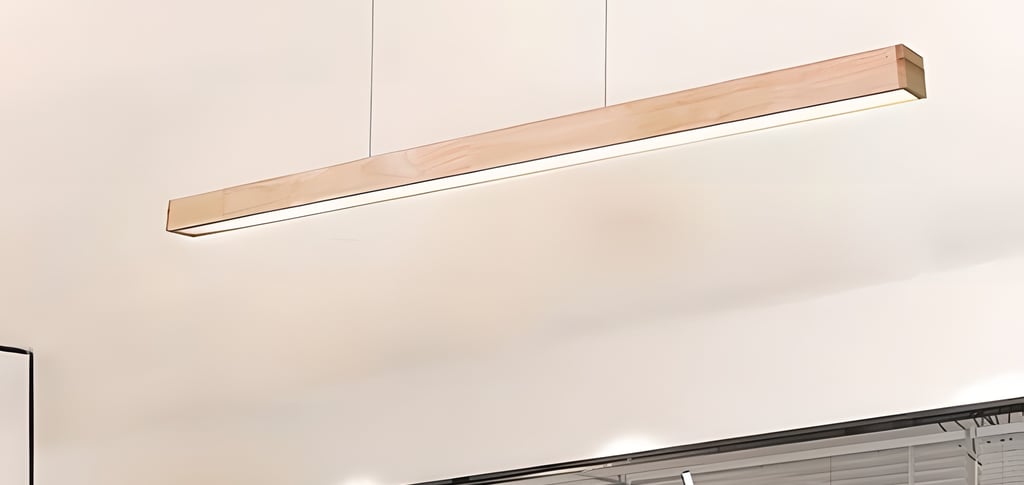Wooden Chandeliers and Lighting Psychology
10/20/20233 min read


Wooden chandeliers, with their warm natural texture and elegant linear design, have become an ideal choice for creating an indoor atmosphere.
In modern home design, lighting is not just about illuminating a space; it also plays a crucial role in regulating moods and influencing behavior.
The psychology of lighting design is the study of how light interacts with the human body through visual and non-visual pathways, affecting mental health and physiological functions.
This blog will delve into how different lighting conditions shape our emotional world and how scientific lighting design can create an indoor environment that is beneficial to both physical and mental health.
The Impact of Light on Humans
The Subtle Connection Between Light and Emotion
The first rays of sunlight filtering through the curtains in the morning bring not just light but also warmth and hope. This feeling is an example of light's direct impact on emotions.
Studies have shown that ample natural light can stimulate the secretion of endorphins in the human body, which are chemicals that can make people feel happy and relaxed.
In a bright and sunny room, people tend to feel more cheerful and positive, while in a dim room, people may feel depressed and negative.
Warm-Toned Light and Happiness: Warm tones like the orange-yellow of dusk or the soft red of candlelight are often associated with warmth and comfort, which can evoke feelings of intimacy and relaxation. Therefore, using warm-colored lighting in the family's relaxation area can help create a cozy family atmosphere and reduce stress.
Cool-Toned Light and Focus: In contrast, cool tones like white or blue light are associated with freshness and efficiency. Using cool-colored lighting in office or study spaces can enhance alertness and focus, making it suitable for environments that require high productivity.
Light Intensity and Emotional Fluctuations: High-intensity lighting is often linked to vitality and positive emotions, making it suitable for commercial displays or public spaces to promote activity and interaction. Soft lighting, on the other hand, can help stabilize emotions and reduce anxiety, making it appropriate for bedrooms or relaxation areas.
The Impact of Light on Biological Rhythms
In addition to emotions, light also has a profound impact on physical health by affecting the body's biological clock, known as the circadian rhythm.
Blue Light and Sleep Quality: Exposure to blue light (such as light emitted from electronic screens) at night can suppress the secretion of melatonin, a key hormone that regulates the sleep-wake cycle. Therefore, reducing exposure to blue light before bed and using warm-colored lighting can help improve sleep quality.
Natural Light and Physical and Mental Health: Natural light is the best source for synchronizing the biological clock. It can regulate blood pressure, heart rate, and hormone levels in the body, promote the synthesis of vitamin D, and is particularly effective in preventing seasonal affective disorder (winter depression). The popularity of office spaces near windows is due to the positive effects of natural light.
Advantages of Wooden Chandelier Design
Wooden chandeliers combine the warmth of natural materials with the simplicity of modern design, offering several advantages:
Warmth of Material: The natural texture and color of wood bring psychological comfort, helping to alleviate stress.
Design Flexibility: The linear design is easy to adjust and can be customized to fit the size and style of the space.
Adjustable Color Temperature: Most wooden chandeliers come with adjustable light sources, allowing users to choose the color temperature according to their needs.
Wooden Linear Lights Improve Mood and Behavior
Dining Room: Enhancing Appetite and Intimacy
In the dining room, the warm light of wooden chandeliers can create a cozy dining atmosphere, stimulating appetite. For instance, a family gathered around a table, bathed in soft light, not only enhances the visual appeal of the food but also strengthens the intimacy among family members.
Office: Boosting Work Efficiency and Comfort
In an office setting, wooden chandeliers can provide evenly distributed light, reducing eye fatigue and improving work efficiency. The warmth of the wood can also alleviate work stress, creating a more comfortable work environment.
Bedroom: Promoting Relaxation and Good Sleep
In the bedroom, especially those with wooden chandeliers equipped with warm light sources, the atmosphere is conducive to relaxation and a good night's sleep. Soft light creates a quiet and serene environment for reading or meditation before bed.
Design Suggestions for Wooden Chandeliers
1. Consider Space Function: Choose an appropriate wooden chandelier based on the function of the space. For example, a dining room may require warmer lighting, while an office may need brighter lighting.
2. Material and Style Coordination: The material and design of the wooden chandelier should be coordinated with the interior decoration style to enhance overall aesthetics.
3. Adjustability of Lighting: Select a wooden chandelier with adjustable brightness and color temperature to accommodate different activities and emotional needs.
4. Safety Considerations: Ensure that the wooden chandelier is securely installed to avoid safety hazards due to improper installation.
